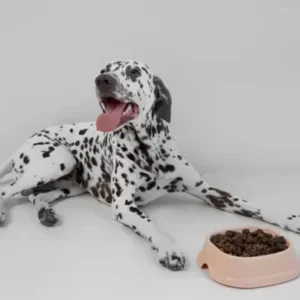Nutritional Benefits of Pineapple for Dogs
Pineapple is packed with vitamins and minerals that can benefit your dog breed, such as:
- Vitamin C
- Vitamin B6
- Vitamin A
- Vitamin K
- Thiamin
- Riboflavin
- Niacin
- Folate
- Manganese
- Copper
- Potassium
While pineapple isn’t a necessary part of your dog’s diet, it can be a fun, occasional treat with added health perks.
Health Risks of Feeding Pineapple to Dogs
While pineapple is generally safe, there are some risks to keep in mind:
- High Sugar Content: Pineapple contains natural sugars, which can lead to weight gain or exacerbate conditions like diabetes if consumed in excess.
- Digestive Upset: Overfeeding pineapple can cause diarrhea or stomach discomfort due to its fiber content and acidity.
- Allergic Reactions: Although rare, some dogs might be allergic to pineapple. Watch for symptoms like itching, swelling, or vomiting after their first taste.
If your dog shows any adverse reactions, stop feeding them pineapple and consult your veterinarian.
How Much Pineapple Should I Give My Dog?
A dog can eat pineapple as an occasional treat, making up at most 10% of their overall diet. The remaining 90% should come from a well-balanced dog food that meets their nutritional needs. Support your dog’s health by offering pineapple as an occasional treat.
Below are guidelines for safely feeding your dog raw pineapple based on size. Remember, when in doubt, always consult your veterinarian for personalized advice.
| Dog Size | Serving Size | Examples of Breeds |
| Extra-small dog (2–20 lbs) | 1–2 small pieces | Chihuahua, Pomeranian, Dachshund |
| Small dog (21–30 lbs) | 2–3 small pieces | Beagle, Cocker Spaniel, Shiba Inu |
| Medium-size dog (31–50 lbs) | 5–6 small pieces | Border Collie, Australian Shepherd |
| Large dog (51–90 lbs) | A handful of pieces | Golden Retriever, Labrador, Boxer |
| Extra-large dog (91+ lbs) | A large handful of pieces | Great Dane, Saint Bernard, Tibetan Mastiff |
Adjust the serving size if necessary and avoid overfeeding, as too much pineapple could lead to digestive upset.
How to Safely Feed Pineapple to Dogs
Follow these tips to safely introduce pineapple into your dog’s diet:
- Prepare Properly: Remove the skin, core, and any tough bits. Only the soft, ripe flesh should be given.
- Use Fresh Pineapple: Opt for fresh over canned pineapple. Canned varieties often contain added sugars or syrups that are harmful to dogs.
- Portion Control: Serve a few small chunks (about the size of a treat). Adjust portion size based on your dog’s size.
- Cut into smaller pieces: Slice the pineapple into small, bite-sized pieces, about 1 inch thick, to make it easy for your dog to chew and digest.
- Frozen Treats: For hot days, frozen pineapple in small pieces for a refreshing snack.
- Raw pineapple: Serve your pup a fresh, juicy piece or two as a simple treat.
- Dried pineapple: Use a dehydrator to dry pineapple chunks at home. Dogs can eat dried pineapple, but since dehydration concentrates sugars, serve it in smaller portions than fresh pineapple.
Unique Ways to Serve Pineapple to Your Dog
Now that we’ve covered the basics of feeding pineapple to your dog, let’s explore the different forms of pineapple and whether they’re safe for your furry friend.
Can Dogs Eat Pineapple Pizza?
No, dogs should not eat pineapple pizza. While pineapple itself is safe for dogs in moderation, pizza is not a suitable food for them. Pizza contains ingredients like cheese, dough, and seasonings (such as garlic and onion), which can be harmful to dogs.
Can Dogs Eat Pineapple Cake or Pineapple Ice Cream?
Dogs should not eat pineapple cake or pineapple ice cream. These treats often contain ingredients like sugar, dairy, and artificial sweeteners (like xylitol), which can upset your dog’s stomach or even be toxic. Pineapple cake and pineapple ice cream are typically high in sugar, fat, and calories, making them unsuitable for dogs.
Can Dogs Eat Pineapple Slices and Chunks?
Yes, dogs can safely enjoy pineapple slices or chunks! Just make sure to remove the spiny skin and core, and cut the fruit into small, bite-sized pieces to prevent choking. Always serve in moderation as a dog treat, not a meal replacement.
Can Dogs Eat Pineapple Juice?
It’s best to avoid pineapple juice for dogs. Store-bought juice often contains added sugars or harmful sweeteners, and even natural juice is too high in sugar for regular consumption. Stick to small amounts of fresh pineapple as a safer option!
Alternatives to Pineapple for Dogs
If pineapple isn’t the right fit for your pup, there are plenty of other dog-friendly fruits to try, including:
- Apples: Dogs can eat apples in moderation.
- Blueberries: Dogs can enjoy blueberries, which are full of antioxidants and low in calories.
- Bananas: Dogs can eat bananas, which are rich in potassium and gentle on the stomach.
- Watermelon: Dogs can eat watermelon, which helps keep them hydrated.
Always introduce new foods gradually and watch for any adverse reactions.








